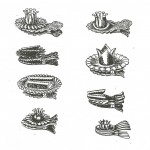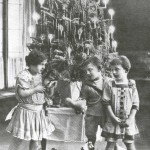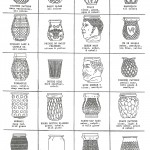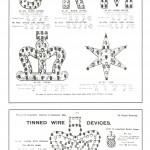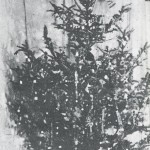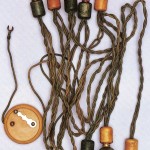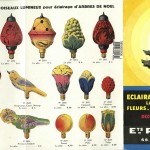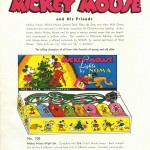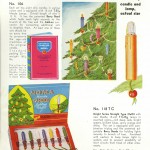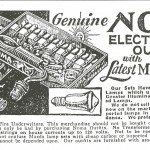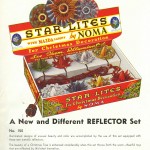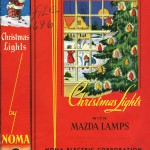As Christmas approaches, many homes across the country are lit up by decorated trees and dazzling light displays. There is something enchanting about those twinkling lights, a magic that has compelled people to light up their holidays for hundreds of years. From the first candle-lit fir tree to the latest music-timed light show, we have been finding ways to brighten dark winter nights.
- Candle clips of various designs provided a surer way of keeping candles upright on the tree. (From pg. 138 of The golden glow of Christmas past, v. 15, no. 6, Dec. 1994)
- The patent for the counterbalanced candleholder, granted to Charles Kirchhof in 1867. (From pg. 12 of The golden glow of Christmas past, v. 16, no. 1, Feb. 1995)
While it is unclear when the first lights adorned Christmas trees, we do know that people have used candles and oil and wicks on trees since the late 18th century. There were many contraptions to attach these lights to trees – from string and wire to eggshells and nutshells. Later developments included metal clips, counterbalanced candle holders, and tin lanterns.
- A tiny kerosene lamp that was another option for lighting your tree. (From pg. 16 of The golden glow of Christmas past, v. 16, no. 1, Feb. 1995)
- A postcard showing a candle-lit tree. (From pg. 3 of The golden glow of Christmas past, v. 15, no. 6, Dec. 1994)
For those who wanted a change from candles, the 1860s saw the development of tiny, kerosene burning lamps, hanging glass shapes filled with kerosene and a wick, and lanterns – three sides made of glass and the fourth of reflective tin – that held alcohol-saturated cloth. These options might sound dangerous, but they can’t hold a candle to a short-lived 1878 endeavor that introduced artificial trees frames made of cast iron tubes. The trees were connected to gas lines and lit up through tiny holes in the branches. Any wonder why those didn’t catch on?
- Illustrations of several pressed-glass lamp patterns and shapes. (From pg. 17 of Bottles and extras, v. 12, no. 12, Dec. 2001)
- Tin forms made for pressed-glass lamps in honor of British coronations and jubilees. (From pg. 4 of The Glass Club bulletin, no. 151, Winter 1986-1987)
Another, safer option to hold candles or oil and wicks was adapted to holiday decorations in the 19th century: the pressed-glass lamp. These lamps (or jars) had been blown on a small scale for several decades before being mass produced in molds the 1830s. The lamps were originally advertised for decorating hotels and businesses, yachts, window sills, and garden paths. Tin forms in the shape of stars or the initials of British monarchs were created to hold the lamps in celebration of coronations and jubilees. Lamps were attached to Christmas trees with wires, and were available in many different colors and a seemingly endless number of patterns and shapes.
- The first electrically-lit Christmas tree in 1882. (From pg. 25 of Christmas through the decades by Robert Brenner, 1993)
- An early string of lights with a battery pack, c.1915. (From pg. 163 of Christmas collectibles by Margaret & Kenn Whitmyer, 1994)
The first electrically-lit Christmas tree appeared in 1882, thanks to Edward Johnson, a partner of Thomas Edison. The White House added lights to their own tree in the late 1890s, but most people used candles into the 1920s, when the price of electric lights decreased and more homes were electrified. The first commercially available string lights were made out of porcelain and cloth cords. These strings didn’t have a plug, and were instead screwed into a light socket. Some lights sets also came with batteries for houses that didn’t have electricity. For the sentimentally-minded, the first electric candles were advertised in the early 1900s.
- A French trade catalog advertising Christmas lights. (From Eclairage d’arbres de Noël, c.1930s. Bib ID: 88844)
- Electric candle lights for the nostalgic. (From pg. 10 of Christmas lights with Mazda lamps, NOMA, 1939. Bib ID: 52586)
- An early advertisement for NOMA string lights. (From pg. 140 of The golden glow of Christmas past, v. 15, no. 6, Dec. 1994)
- An instructional image for how to power early electric string lights. (From pg. 25 of Glasfax, v. 15, no. 4, Nov. 1983)
- The cover of a 1939 NOMA catalog. (From Christmas lights with Mazda lamps, NOMA, 1939. Bib ID: 52586)
As technology advanced, string lights became more useable and less expensive. Blade plugs were developed, whole strings didn’t go dark if one light burned out, and bulbs were created in endless shapes and colors. Bubble lights premiered before World War II, but it wasn’t until after the war that their popularity exploded. Pre-lit Christmas trees were marketed, and string lights were specifically developed for outdoor use. Twinkle lights (blinking lights) were developed in the mid-1950s, along with the small-bulb string lights many people use as Christmas lights today (also known as mini lights, fairy lights, and holiday lights).
 Modern Christmas trees might be decorated with mini lights, candles, bubble lights, or fiber optics. Some people spend huge amounts of time decorating their homes and trees, going so far as to have musical light shows in their yards. Small and simple or large and complex, all these displays add a little light to those dark winter nights.
Modern Christmas trees might be decorated with mini lights, candles, bubble lights, or fiber optics. Some people spend huge amounts of time decorating their homes and trees, going so far as to have musical light shows in their yards. Small and simple or large and complex, all these displays add a little light to those dark winter nights.
The Rakow Research Library has a variety of materials to help you research the history of holiday lighting in more depth, or look up information on your own collection of lights. We have trade catalogs featuring Christmas lights, advertisements, and articles, along with a number of published books on the history of Christmas traditions, price guides and overviews of the Christmas collectibles market.
Read about the history of Christmas ornaments and check out some of the Christmas lamps and lights in the CMoG collection.
The Rakow Research Library is open to the public 9am to 5pm every day. We encourage everyone to explore our collections in person or online. If you have questions or need help with your research, please use our Ask a Glass Question service.

